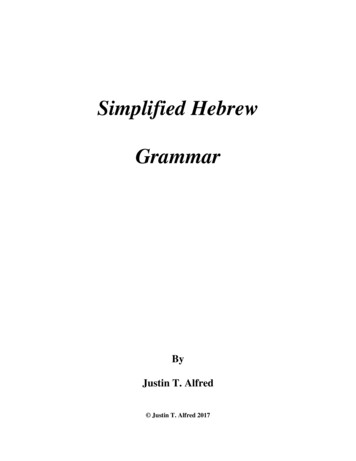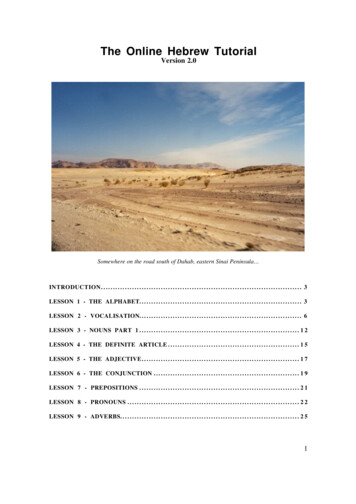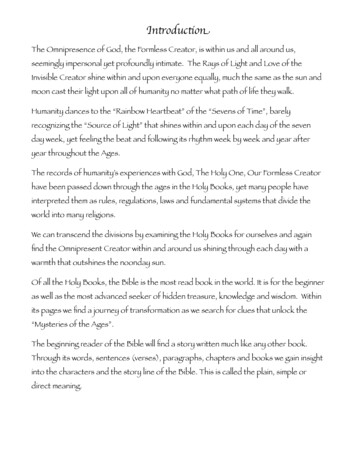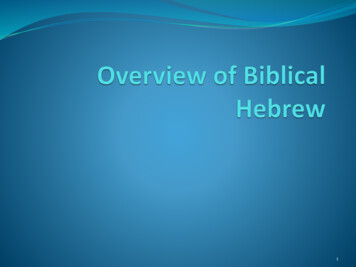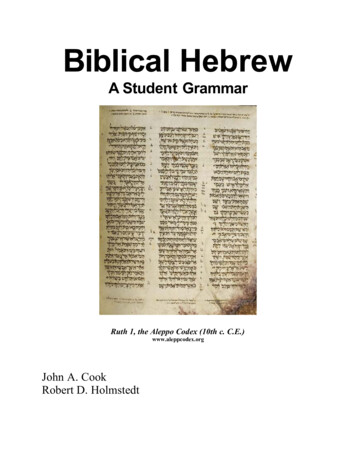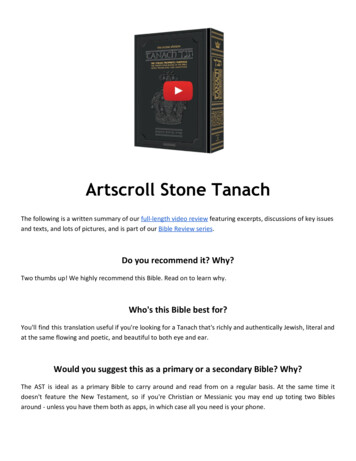
Transcription
Torah Judaism International’s“Ways of Torah”Hebrew Siddurwww.TorahJudaism.orgPrinted by BeJEWISH PublishingAll rights reserved; DorDeah.com 2012BJPub.comThis Siddur can be heard on our online his siddur was developed for the purpose of giving individuals abetter grasp on the duty of prayer. Unlike any other siddur, the“Ways of Torah” prayer book is based on the structure of prayeras laid down in the Rambam’s Mishneh Torah, while including onlythose words of prayer in common to the Ashkenazi andEdoth ha‐Mizrah traditions, as well as in common with thewordings of the traditions of the R’ Saadia Gaon and the Rambam.The result is the world’s most concise halachic prayer book evercomplied in over a millennium. The goal of this siddur is to makeprayer meaningful again. We therefore intend to translate each ofour prayer books into only one language, so as not to compromisedevotion.We at Torah Judaism International hope you enjoy the“Ways of Torah” Hebrew Siddur.2
צניעות ותפילה Seni’uth w‐TefilaModesty & Prayer4–6 הנחת תפילין Hanahath TefillinTefillin Wrapping7–8 מצבי תפילה Masaveh TefilaPrayer Postures9 – 13Qiryath Shema Al ha‐MitaBedtime Shema14Birkoth ha‐ShaharMorning Blessings14 – 18ShaharithMorning Prayer18 – 29MinhaAfternoon Prayer30 – 34Sefirath ha‐OmerCounting the Omer35 – 36 ערבית ArvithNighttime Prayer37 – 44 הבדלה HavdalahSabbath Conclusion45Hadlaqath Ner ShabbathSabbath Candle Lighting46Arvith ShabbathSabbath Nighttime Prayer47 – 51Qidush52Shaharith ShabbathSabbath Morning Prayer53 – 62Musaf ShabbathSabbath Additional Prayer62 – 65Musaf Shabbath Rosh HodeshSabbath New Moon68 – 71Minha ShabbathSabbath Afternoon Prayer72 – 78Hallel79 – 81Musaf Rosh HodeshNew Moon Additional Prayer82 – 86Birkath ha‐LevanaNew Moon Blessing86Hannuka86 ק"ש על המטה ברכות השחר שחרית מנחה ספירת העומר הדלקת נר שבת ערבית שבת קידוש שחרית שבת מוסף שבת מוסף שבת ראש חדש מנחה שבת הלל מוסף ראש חדש ברכת הלבנה חנוכה ברכות שנות Berakhoth ShonothVarious Blessings87 – 90 על גלות וגאולה Al Galuth w‐Ge’ulaBlessings of Deliverance90 – 91 על קיום מצות Al Qiyum MiswothBlessings of Commandments91Birkoth Hana’ahBlessings of Benefit92Al AkhilaBlessings for Eating92 – 93Birkath ha‐MazonBlessing After Meal94 – 95Tosafoth l‐TefilaPrayer Additions95 תפילה קצרה Tefila QesaraThe Short Prayer96 – 97 זמני תפילה Zemanei TefilaPrayer Times98 – 99 יחוד הבורא Yihud ha‐BorehMonotheism99 ‐ 100 ברכות הנאה על אכילה ברכת המזון תוספות לתפילה 3
ModestyBefore praying, one should make sure his clothing is fit for 'standing before God.'One should not pray in an undershirt or without his head covered ‐ whether maleor female, nor with his calves showing, unless one would stand that way beforeesteemed individuals of his locale; and students of the Sages pray cloaked in aprayer shawl; (Laws of Prayer 5:5)The Hebrew word for modesty, "sani'uth," is usually rendered as 'modesty,' butthe word also indicates restraint, subduedness, and humility ‐ all fundamental toliving a life in the service of God. And so it is written, "It has been told to you, Oman, what is good, what the LORD requires of you: that you act justly, lovecompassion, and walk subdued (hasneiya') with your God;" (Micah 6:8)Despite the decline of modesty around us, the essence of modesty (sani'uth)remains the same. One's thoughts, words, deeds, and dress should reflect a stateof humility and subduedness before the All‐Knowing Creator.This is why our Sages taught that one should behave modestly even when no oneelse is present; for there is One Whose knowledge is ever present, and He isworthy of our reverence. Jewish modesty, or more accurately ‐ subduedness, ismore importantly about inspiring awe and reverence for the Creator, than aboutsexuality.4
The Jewish Woman5
This is why our Sages taught that students of the Sages should not walk about with their headsuncovered or in tight or transparent clothing that reveals the form of the body. Similarly, theytaught that students of the Sages should wear long sleeves and that their garment extend tothe ankle; (Laws of Character, chap. 5)The Sages taught that husbands provide their wives with modest loose fitting clothing, includinghead coverings that she can wrap herself in; (Laws of Idolatry 12:13; Laws of Women 13:13; 24:11‐12)Due to the norms and influence of western culture, the level of modesty in dress amongmodern day religious Jews has drastically changed from what it was in the not so distant past.The extent of this relatively quick change is especially pronounced among the Jews of Yemenwho, within only 60 years, saw their men abandon robes for short sleeve shirts and theirwomen veils for wigs, or no hair covering at all.The historical manner of head covering for Jewish women was that in public places theycovered both their hair and their necks, and elsewhere outside of their homes they werecareful to at least cover their hair; (Laws of Women 13:13; 24:11‐12)Our Sages taught, "The daughters of Israel should not go about with their heads uncovered in amarket place, whether she is available for marriage or already married."(Laws of Forbidden Relations 21:17)If a woman should be forbidden from covering her neck because the practice is also foundamong Muslims, even though Jewish women covered their necks long before the rise of Islam,then please consider the fact that many Eastern Orthodox Christian women cover their hairexactly as most religious Jewish women today do ‐ they cover their hair while exposing theirneck. Christians also give charity to the poor and do other things in common with Torahobservance. Should we stop these practices just because they also do them? There are also anumber of countries where the Muslim women cover their hair but not their necks. If a Jewishwoman should not cover her neck because Muslim women also cover their necks, then sheshould also not cover her hair while exposing her neck the way many Eastern OrthodoxChristians, Ana‐baptists, and some Sub‐Saharan Muslims do. But rather, as Rabbi Avraham,son of the Rambam, wrote: "No Torah commandment or practice that the prophets orTalmudic tradition teach may be ceased just because the nations copy it."6
7
TEFILLINThe commandment of tefillin can only be fulfilled from after dawn till sunset, and not on theSabbath or Biblical holy days. It is only mandatory for men.Right handed individuals place tefillin on their left arm. A left handed individual puts the armtefillin on his right arm. An ambidextrous person places it on the left arm. The box of the armtefillin should be placed on the middle point of one's bicep pointing inward towards the heart. Itshould be roughly two finger‐breadths from the inner side of the elbow joint. After putting thearm tefillin on one's arm, but before wraping it, bless: וֹתיו ָ ֲא ֶשׁר ִק ְדּ ָשׁנוּ ְבּ ִמ ְצ , עוֹלם ָ ֱאל ֵֹהינוּ ֶמ ֶל ְך ָה , אַתּה יהוה ָ רוּך ְ ָבּ . יח ְתּ ִפ ִלּין ַ ִ וְ ִצוָּנוּ ְל ַהנּ There is no required amount of times one must wind the strap around one's arm. The strapmust be able to reach the middle finger, wrap around it 3 times, and be tied. The diagramshows the tradition of wrapping tefillin around one's hand among the Yemenite students ofRambam the Sefaradi. They continued to go by the Rambam until modern times.Once one finished tying the arm tefillin strap in place, one then places the head tefillin on one'shead. If an interruption that was unrelated to putting on tefillin was made between putting onthe arm tefillin and putting on the head tefillin, one says the following blessing immediatelybefore putting on the head tefillin: וֹתיו ָ ֲא ֶשׁר ִק ְדּ ָשׁנוּ ְבּ ִמ ְצ , עוֹלם ָ ֱאל ֵֹהינוּ ֶמ ֶל ְך ָה , אַתּה יהוה ָ רוּך ְ ָבּ . וְ ִצוָּנוּ ַעל ִמ ְצוַת ְתּ ִפ ִלּין The box of the head tefillin should be positioned between the eyes on the hair just above thehair line. The knot of the head tefillin straps should be placed in the middle of the back of thehead at the highest point on the neck right where the skull begins. The straps of the head tefillinshould be long enough to encircle the head and descend down to one's naval or slightly above it.The straps that descend down from the head tefillin can be tucked in between one's undershirtand outer shirt to prevent the straps from causing distraction when bowing.When removing tefillin, one should first remove the head tefillin and then the arm tefillin. Thearm tefillin should not be placed below the head tefillin when placing tefillin in a container.8
9
1) See p. 10;2) The "Standing Prayer" (the 'Amida') is said in a standing position with feet together, eyeslowered, and the right hand clasped over the left hand, opposite your heart.3) There are five places in the "Standing Prayer" where one bends down on the knees; thereare three places where one bends down upon saying רוּך ְ ָבּ and stands back up when he reaches יהוה : at the beginning and end of the 1st blessing, and at the end of the 18th blessing. Onealso bends down at the beginning of the 18th blessing upon saying the first word of thatblessing ‐ "We." and stands back up when he reaches the words "the LORD." And one bendsdown a 5th time when he reaches the word "Amen," upon concluding the final blessing of the"Standing Prayer."3a) It is permitted to place one's hands on the floor when kneeling down, and it is wise to do soin order to provide stability when kneeling and standing back up from kneeling. It is alsopermitted to keep one's right hand clasped over the left when one kneels, as appears inimage 3; however, this may impair stability. One is only required to bow over to the extent thathis vertebrae protrude and he has the form of an arch. One need not arch himself over to thisextent if it causes pain. One is not required to touch his face to the floor during the 5 bows ofthe "Standing Prayer" as done in image 8 and 9. However, Rabbi Avraham explains that it ispermitted and proper to do so. He writes that the Sages did not require that one touch his faceto the floor during the "Standing Prayer" only so as not to overburden the people. Placing one'sface to the floor can be cumbersome if one's tefillin are not small; the posture of image 9 is theleast cumbersome with larger tefillin, but would require larger synagogues.4) One can bow like this when pressured not to bow to the ground. After bending down at theword "Amen" at the conclusion of the "Standing Prayer," one remains bent over and says, "Maythe utterance of my mouth and the deliberation of my heart be desirable before You, O LORD,my Rock and my Redeemer;" (Psalm 19:15). Upon completing the recital of Ps. 19:15, one takes3 steps back while remaining bent over and then 'gives peace' by tilting his head to the left andthen to the right; one then lifts his head from this concluding 5th bow of the "Standing Prayer."5) After taking 3 steps back and 'giving peace' by tilting the head to the left and right, one thenlifts one's head from the 5th bow of the "Standing Prayer," bringing oneself to astanding position. When praying with a minyan (quorum of 10 Jewish males age 13 and up)one remains standing the duration of the repetition of the "Standing Prayer."6) After lifting one's head from the 5th and final bow of the "Standing Prayer," one who prayedwithout a minyan (quorum of 10 Jewish males age 13 and up) should then sit to the ground toprostrate before God. When a quorum of 10 adult Jewish males prayed together, the entirecongregation sits to the ground immediately following the repetition of the "Standing Prayer."10
6a) One who is unable to sit upon his knees can sit however he is able, giving preference to themost reverent manner he is able to sit that also allows him to concentrate on prayer. One whoshould prostrate in the manner shown in image 7a can begin by sitting as in image 6a.6b) It is permitted to use one's hands to seat oneself in preparation for prostration, as it ispresumed that one is praying in a clean environment.7) One can use his hands to lower his face to the ground.7a) One who prayed in a place with a stone floor should not press his face to the floor unlesshe has something with which to separate between his face and the stone. If he has nothing toseparate between his face and the stone floor, he should tilt his body slightly so that his facedoes not press into the stone, or he can move to another location and prostrate. (Idolatry 6:12)An important person, such as the esteemed individual who should act as prayer leader, shouldnot press his face to the ground during the prayers of supplication that follow the "StandingPrayer," even if he would not be pressing his face on stone. This is "so that the Name of Godwill not be desecrated if he is perceived as having not been answered."8) After lifting one's head from the 5th and final bow of the "Standing Prayer," one sits to theground and then falls prostrate before God with his face to the ground, making all thesupplications of his heart that he desires. When one is unable to prostrate fully(hishtahawaiya), one can bow (qida) as shown in image 8.9) ".one praying should be careful to do these; if he does not do them either because he waspressured, coerced, or simply transgressed, it does not delegitimize the prayer. These are they:.bending down, and prostration." (Laws of Prayer 5:1)"What is implied by 'prostration' (hishtahawaiya)? After one lifts his head from the 5thplace of bending down in the 'Standing Prayer,' one sits on the ground and falls upon his face onthe ground; one then supplicates with all the supplications that he desires.Any place 'bending down' (keri'a) is mentioned, it is done on the knees; 'bowing' (qida) ‐ on theface; 'prostration' ‐ one's arms and legs are spread out so that one lay flat face downon the ground." (Laws of Prayer 5:14)1) This is the manner in which our forefathers and the prophets of old sat during prayer. Whensitting during prayer, it is proper sit in a reverent manner, for one should pray in a spirit ofreverence. Rabbi Avraham, son of the Rambam, wrote: "During the parts ofworship wherein one sits, such as the duration of the daily recitation of Psalms 145 ‐ 150 orduring the 'Shema Recitation' and its related blessings, one should be careful that he does notseat himself in just any random position. He should not sit in a position which expresses lack ofregard for prayer or lack of etiquette, such as reclining on a wall or some otherobject; nor in the manner that one sits while relaxing at home, at a local gathering place, orwhile among friends or family. Rather, one should sit during prayer in the same manner that it is11
proper to stand during prayer ‐ in the words of the Talmudic Sages, 'as a servant before hismaster.' Likewise, one sitting while serving God in prayer should sit in the manner of a servantwho has etiquette in the presence of his lord who has permitted him to sit."The Sages did not obligate us that we position our arms or hands in a particular fashion whilesitting; but they instructed that we can clasp the right hand over the left hand opposite theheart when reciting the "Standing Prayer" 'as a servant before his master,' and that one not resthis hands at his sides.Though not required by halacha, lifting hands in prayer is an ancient Jewish practice. RabbiAvraham, the son of the Rambam, wrote: "One is obliged, and it is also proper, that both handsbe spread forth at times of supplication, such as while sitting during the 'Lay us down' blessing,during the intermediate blessings of the 'Standing Prayer,' and during any other similar context.For thus was the practice of the prophets while making their supplications, in the manner that adestitute person begs from the one who can impart to him charity. Of King Solomon it is written,"his hands were stretched forth heavenward;" Moses, master of prophets, stated "I shall stretchforth my hands to the LORD." [.] Lifting one's hands is reasonable since a person, whenbeseeching his Creator, directs his heart to the Creator of existence, and turns his eyes to thevisible heights of existence ‐ the heavens which testify to the greatness of their Creator." RabbiAvraham then explains how lifting hands awakens the individual to the unfathomable greatnessof God. He also continues on to explain how the ignorant and unlearned mistake the Biblicalfigure of speech that "God in the heavens" to mean that God is literally located at someparticular location in the heavens and that it may therefore be irreverent to lift one's headheavenward. Rabbi Avraham calls such individuals deniers of God's incorporeity.Rabbi Avraham disproves the claim that only the most righteous can lift their hands in prayer:"The claim that stretching forth hands during prayer is forbidden to the average individual isinvalid speech the rottenness of which is apparent. A logical difficulty arises from such a claim;namely, King Solomon spread out 'his hands heavenward,' and yet he was not at all at thespiritual level of Moses, of whom it is said 'I shall spread my hands to the LORD.' And similarly,another logical difficulty arises in the claim that the average individual is prohibited from liftinghands in prayer in that the Talmud states: "There is a law learned from Hanna, ‐ '.and Hannaspoke in her heart;' from this it is taught that one should speak softly during the 'StandingPrayer;' yet it could be said that not everyone who prays is on the spiritual level of Hanna! Andsuch a claim would also logically imply that we are forbidden from standing during prayer,because Abraham our forefather stood during prayer, as it is written: 'to the place where hestood [in prayer].' And Moses, the master of prophets, stood, as it is written: '.and I stood onthe mountain.' How, therefore, can someone not on the spiritual level of Abraham or Moses beallowed to stand?! Rather, notice that with regard to all Israel, the prophet said: 'Let's lift ourhearts, with our hands, to God in heaven,' just as he stated concerning all Israel: 'let us searchout our ways and investigate them.'Therefore, taking these two verses together it becomes apparent that if 'Let's lift our hearts,using our hands, to God in heaven' is not directed to all people, then it would necessitate that12
the verse that demands repentance from sins is likewise not proper for all peoples, Godforbid! This erroneous way of thinking, this distortion of reason, is an explicit error whenexamined in depth. This is an error which can only be found among total ignoramuses,persons unlearned in Torah, or with a bad leader who bases such reasoning on misleadingimaginations, for the gate to the service of God is open; [.] and we have not found any placewhere the Sages of blessed memory forbade any of the bodily postures of worship that can befound in the prophetic writings, with the exception of a restriction on an 'important individual'from pressing his face flat upon the ground when making public supplications; and this was onlyso that the Name of God will not be desecrated if he is perceived as having not been answered."Regarding Psalm 95:6, “Come! Let's prostrate, bow down, and sit on our knees‐ in the presence of the LORD our Maker," Rabbi Avraham explains:“King David’s intention by first writing ’let’s prostrate’ was that this is the preferableposture for worshiping the LORD. But since it is not possible to constantly prostrate, bodilyworship of the LORD is therefore not based solely upon prostration to the exclusion of otherpostures of worship; but also, 'we shall bow down.’ And since this is likewise difficult toconstantly do, therefore 'we shall sit upon our knees.’ King David did not mention any otherposture than these since he was unfamiliar with the outward semblance of worship prevalentamong the negligent, the drunken ones now found among us following the [many centuries of]difficulties in the exile.”* “ha‐Maspiq l‐'Ovdei HaShem” by R’ Avraham son of Maimonides, p.100‐102 and p.13013
Bedtime Shema ק"ש שעל המטה Upon entering the bed to sleep at night, bless: אַתּה יהוה ֱ , אלֹ ֵהינוּ ֶמ ֶל ְך ָהעוֹ ָלם ַ , ה ַמּ ִפּיל ֶכּ ְב ֵלי ִשׁי ָנה ַעל ֵעי ַני וּ ֵמ ִאיר רוּך ָ ָבּ ְ ילנִ י ִמ ֵיּ ֶצר ָרע וּ ִמ ֶפּ ַגע ָרע , ֶיך יהוה ֱאלֹ ַהי ֶ , שׁ ַתּ ִצּ ֵ ְל ִאישׁוֹן ַבּת ָעיִ ן . יְ ִהי ָרצוֹן ִמ ְלּ ָפנ ָ ישׁן ַה ָמּ ֶות וְ אַל יְ ַב ֲהלוּנִ י ֲחלוֹמוֹת ָר ִעים וְ לֹא ִה ְרהוּ ִרים ָר ִעים , וְ ָה ֵאר ֵעינַי ֶפּן ִא ַ אַתּה יהוה ַ , ה ֵמּ ִאיר ְל ָכל ָהעוֹ ָלם . רוּך ָ ידנִ י ְל ָשׁלוֹם ָ . בּ ְ וְ ַת ֲע ִמ ֵ ְשׁ ַמע ִי ְשׂ ָר ֵאל יהוה ֱאלֹ ֵהינוּ יהוה ֶא ָחד : וּב ָכל ְמאֹ ֶד ָך : וְ ָהיוּ ַה ְדּ ָב ִרים ַפ ְשׁ ָך ְ וּב ָכל נ ְ יך ְ . בּ ָכל ְל ָב ְב ָך ְ אָה ְב ָתּ ֵאת יהוה ֱאלֹ ֶה ָ וְ ַ ֶיך וְ ִד ַבּ ְר ָתּ ָבּם ְ , בּ ִשׁ ְב ְתּ ָך ָה ֵא ֶלּה ֲא ֶשׁר אָנֹ ִכי ְמ ַצוְּ ָך ַהיּוֹם ַ , על ְל ָב ֶב ָך : וְ ִשׁנַּנְ ָתּם ְל ָבנ ָ ָד ָך , וְ ָהיוּ וּק ַשׁ ְר ָתּם ְלאוֹת ַעל י ֶ קוּמ ָך ְ : וּב ֶ וּב ָשׁ ְכ ְבּ ָך ְ וּב ֶל ְכ ְתּ ָך ַב ֶדּ ֶר ְך ְ , ית ָך ְ ְבּ ֵב ֶ יך : וּב ְשׁ ָע ֶר ָ ית ָך ִ וּכ ַת ְב ָתּם ַעל ְמזֻזוֹת ֵבּ ֶ ֶיך ְ : ְלטֹ ָטפוֹת ֵבּין ֵעינ ָ ” “If overcome by sleep, recite even the first verse alone or verses of compassion, and sleep. ) (Hil. Tefila 7:2 Morning Blessings ברכות השחר Upon awakening, one blesses while still in bed: אַתּה נְ ַפ ְח ָתּהּ ִבּי , אַתּה יְ ַצ ְר ָתּהּ; ָ אתהּ; ָ אַתּה ְב ָר ָ ָת ָתּ ִבּי ְטהוֹ ָרה ָ . ֱאלֹ ַהי , נְ ָשׁ ָמה ֶשׁנּ ַ ירהּ ִבּי ֶל ָע ִתיד ָלבֹא ָ . כּל וּל ַה ֲח ִז ָ אַתּה ָע ִתיד ִל ְטּ ָלהּ ִמ ֶמּנִּ י ְ אַתּה ְמ ַשׁ ְמּ ָרהּ ְבּ ִק ְר ִבּי , וְ ָ וְ ָ רוּך ֲשׂים ָ . בּ ְ ֶיך יהוה ֱאלֹ ַהי ִרבּוֹן ָכּל ַה ַמּע ִ ְז ַמן ֶשׁ ַהנְּ ָשׁ ָמה ְב ִק ְר ִבּי מוֹ ֶדה ֲאנִ י ְל ָפנ ָ ָרים ֵמ ִתים . אַתּה יהוה ַ , ה ַמּ ֲח ִזיר נְ ָשׁמוֹת ִל ְפג ִ ָ Upon passing your hands over your eyes: אַתּה יהוה ֱ , אלֹ ֵהינוּ ֶמ ֶל ְך ָהעוֹ ָלם , פּוֹ ֵק ַח ִעוְ ִרים . רוּך ָ ָבּ ְ Upon sitting up in bed: סוּרים . אַתּה יהוה ֱ , אלֹ ֵהינוּ ֶמ ֶל ְך ָהעוֹ ָלם ַ , מ ִתּיר ֲא ִ רוּך ָ ָבּ ְ Upon lowering your feet and placing them on the ground: אָרץ ַעל ַה ָמּיִ ם . אַתּה יהוה ֱ , אלֹ ֵהינוּ ֶמ ֶל ְך ָהעוֹ ָלם , רוֹ ַקע ָה ֶ רוּך ָ ָבּ ְ Upon standing: פוּפים . אַתּה יהוה ֱ , אלֹ ֵהינוּ ֶמ ֶל ְך ָהעוֹ ָלם , זוֹ ֵקף ְכּ ִ רוּך ָ ָבּ ְ 14
Upon putting on one’s clothes: ֻמּים . אַתּה יהוה ֱ , אלֹ ֵהינוּ ֶמ ֶל ְך ָהעוֹ ָלם ַ , מ ְל ִבּישׁ ֲער ִ רוּך ָ ָבּ ְ Upon donning one’s head garment: אָרה . אַתּה יהוה ֱ , אלֹ ֵהינוּ ֶמ ֶל ְך ָהעוֹ ָלם , עוֹ ֵטר יִ ְשׂ ָר ֵאל ְבּ ִת ְפ ָ רוּך ָ ָבּ ְ Upon putting on one’s belt: בוּרה . אַתּה יהוה ֱ , אלֹ ֵהינוּ ֶמ ֶל ְך ָהעוֹ ָלם , אוֹזֵר יִ ְשׂ ָר ֵאל ִבּ ְג ָ רוּך ָ ָבּ ְ Upon putting on one’s shoes: אַתּה יהוה ֱ , אלֹ ֵהינוּ ֶמ ֶל ְך ָהעוֹ ָלם ֶ , שׁ ָע ָשׂה ִלי ָכּל ָצ ְר ָכי . רוּך ָ ָבּ ְ Upon going to depart on the way: ָבר . ֲדי ג ֶ אַתּה יהוה ֱ , אלֹ ֵהינוּ ֶמ ֶל ְך ָהעוֹ ָלם ַ , ה ֵמּ ִכין ִמ ְצע ֵ רוּך ָ ָבּ ְ Upon hearing the sound of a rooster: אַתּה יהוה ֱ , אלֹ ֵהינוּ ֶמ ֶל ְך ָהעוֹ ָלם ַ , הנּוֹ ֵתן ַל ֶשּׂ ְכוִ י ִבּינָה רוּך ָ ָבּ ְ וּבין ָליְ ָלה . ְל ָה ִבין ֵבּין יוֹם ֵ Bless daily: אַתּה יהוה ֱ , אלֹ ֵהינוּ ֶמ ֶל ְך ָהעוֹ ָלם ֶ , שׁלֹּא ָע ַשׂנִ י גוֹי ) . גוֹיָה (Women: . רוּך ָ ָבּ ְ אַתּה יהוה ֱ , אלֹ ֵהינוּ ֶמ ֶל ְך ָהעוֹ ָלם ֶ , שׁלֹּא ָע ַשׂנִ י ָע ֶבד ִ ) . שׁ ְפ ָחה (Women: . רוּך ָ ָבּ ְ Men bless: אַתּה יהוה ֱ , אלֹ ֵהינוּ ֶמ ֶל ְך ָהעוֹ ָלם ֶ , שׁלֹּא ָע ַשׂנִ י ִא ָשּׁה . רוּך ָ ָבּ ְ Women bless: רוּך ֶשׁ ָע ַשׂנִ י ִכּ ְרצוֹנוֹ . ָבּ ְ Torah is not contemplated upon in the bathroom. Therefore, before entering we say: אָדם . כוּבּ ִדים ְמ ָשׁ ְר ֵתי ֶע ְליוֹן; ִה ְז ִהירוּ ִבּי ֶ , שׁזוּ ַדּ ְרכּוֹן ֶש ִלּ ְבנֵי ָ ִה ְכ ַבּדוּ ְמ ָ Upon leaving the bathroom: וּב ָרא בוֹ אָדם ְבּ ָח ְכ ָמה ָ ָצר ֶאת ָה ָ אַתּה יהוה ֱ , אלֹ ֵהינוּ ֶמ ֶל ְך ָהעוֹ ָלם ֲ , א ֶשׁר י ַ רוּך ָ ָבּ ְ אַתּה רוּך ָ לוּלים ֶ , שׁ ִאם יִ ָסּ ֵתם ֶא ָחד ֵמ ֶהם אוֹ יִ ָפּ ֵת ַח ֵ , אינוּ ִמ ְת ַקיֵּם ָ . בּ ְ לוּלים ֲח ִ ֲח ִ וּמ ְפ ִליא ַלעֲשׂוֹת . יהוה , רוֹ ֵפא ָכל ָבּ ָשׂר ַ 15
Upon washing one’s face in the morning: נוּמה ֵמ ַע ְפ ַע ָפּי . וּת ָ ֲביר ִשׁנָה ֵמ ֵעינַי ְ אַתּה יהוה ֱ , אלֹ ֵהינוּ ֶמ ֶל ְך ָהעוֹ ָלם ַ , ה ַמּע ִ רוּך ָ ָבּ ְ ירה; ילנִ י ִל ְד ַבר ֲע ֵב ָ ילנִ י ִל ְד ַבר ִמ ְצ ָוה וְ אַל ַתּ ְר ִג ֵ ֶיך יהוה ֶ , שׁ ַתּ ְר ִג ֵ יְ ִהי ָרצוֹן ִמ ְלּ ָפנ ָ ֵצר ָרע . וְ כוֹף ֶאת יִ ְצ ִרי ְל ִה ְשׁ ַתּ ְע ֶבּד ָל ְך . ֵצר טוֹב , וְ אַל ַת ְשׁ ֵלט ִבּי יּ ֶ וְ ַת ְשׁ ֵלט ִבּי י ֶ אַתּה יהוה , גּוֹ ֵמל רוּך ָ וּב ֵעינֵי ָכל רוֹאַי ָ . בּ ְ ֶיך ְ וּל ַר ֲח ִמים ְבּ ֵעינ ָ וּל ֶח ֶסד ְ וּתנֵנִ י ְל ֵחן ְ ְ ֲח ָס ִדים טוֹ ִבים . One blesses before washing hands, whether before eating bread or a food that is dipped, before reciting Shema or the Amida prayer, or learning Torah before sunrise: וֹתיו אַתּה יהוה ֱ , אלֹ ֵהינוּ ֶמ ֶל ְך ָהעוֹ ָלם ֲ , א ֶשׁר ִק ְדּ ָשׁנוּ ְבּ ִמ ְצ ָ רוּך ָ ָבּ ְ ָדיִ ם . ילת י ַ וְ ִצוָּנוּ ַעל נְ ִט ַ Before putting on the arm tefillin, bless: וֹתיו אַתּה יהוה ֱ , אלֹ ֵהינוּ ֶמ ֶל ְך ָהעוֹ ָלם ֲ , א ֶשׁר ִק ְדּ ָשׁנוּ ְבּ ִמ ְצ ָ רוּך ָ ָבּ ְ יח ְתּ ִפ ִלּין . וְ ִצוָּנוּ ְל ָהנִ ַ If a separation unrelated to putting on tefillin was made between putting on the arm and head tefillin, bless the following immediately before putting on the head tefillin: וֹתיו אַתּה יהוה ֱ , אלֹ ֵהינוּ ֶמ ֶל ְך ָהעוֹ ָלם ֲ , א ֶשׁר ִק ְדּ ָשׁנוּ ְבּ ִמ ְצ ָ רוּך ָ ָבּ ְ וְ ִצוָּנוּ ַעל ִמ ְצוַת ְתּ ִפ ִלּין . Before cloaking oneself in a talith, bless: וֹתיו אַתּה יהוה ֱ , אלֹ ֵהינוּ ֶמ ֶל ְך ָהעוֹ ָלם ֲ , א ֶשׁר ִק ְדּ ָשׁנוּ ְבּ ִמ ְצ ָ רוּך ָ ָבּ ְ יצית . וְ ִצוָּנוּ ְל ִה ְת ַע ֵטּף ְבּ ִצ ִ Blessings of the Torah ברכות התורה (Hil. Tefila 7,11) A person must daily to bless: וֹתיו וְ ִצוָּנוּ ַעל ִדּ ְב ֵרי אַתּה יהוה ֱ , אלֹ ֵהינוּ ֶמ ֶל ְך ָהעוֹ ָלם ֲ , א ֶשׁר ִק ְדּ ָשׁנוּ ְבּ ִמ ְצ ָ רוּך ָ ָבּ ְ יפיּוֹת ַע ְמּ ָך ֵבּית וּב ִפ ִ ֲרב נָא יהוה ֱאלֹ ֵהינוּ ֶ , את ִדּ ְב ֵרי תוֹ ָר ְת ָך ְבּ ִפינוּ ְ תוֹ ָרה ְַ . הע ֵ ֻלּנוּ יוֹ ְד ֵעי ְשׁ ֶמ ָך וְ לוֹ ְמ ֵדי תוֹ ָר ְת ָך . ַחנוּ וְ ֶצ ֱא ָצ ֵאינוּ כּ ָ יִ ְשׂ ָר ֵאל; וְ נִ ְהיֶה ֲאנ ְ תּוֹרה . נוֹתן ַה ָ אַתּה יהוה ֵ , רוּך ָ ָבּ ְ ָתן ָלנוּ אַתּה יהוה ֱ , אלֹ ֵהינוּ ֶמ ֶל ְך ָהעוֹ ָלם ֲ , א ֶשׁר ָבּ ַחר ָבּנוּ ִמ ָכּל ָה ַע ִמּים וְ נ ַ רוּך ָ ָבּ ְ אַתּה יהוה , נוֹ ֵתן ַהתּוֹ ָרה . רוּך ָ ֶאת תּוֹ ָרתוֹ ָ . בּ ְ 16
One then reads some words of Torah; for example: וַיְ ַד ֵבּר יהוה ֶאל מֹ ֶשׁה ֵלּאֹמר : אַהרֹן וְ ֶאל ָבּנָיו ֵלאמֹר , ַדּ ֵבּר ֶאל ֲ כֹּה ְת ָב ְרכוּ ֶאת ְבּנֵי יִ ְשׂ ָר ֵאל . אָמוֹר ָל ֶהם : יְ ָב ֶר ְכ ָך יהוה וְ יִ ְשׁ ְמ ֶר ָך : ֶךּ : יחנּ ָ יך וִ ֻ ָאר יהוה ָפּנָיו ֵא ֶל ָ יֵ ָשׂם ְל ָך ָשׁלוֹם : יך וְ י ֵ יִ ָשּׂא יהוה ָפּנָיו ֵא ֶל ָ ַאנִ י ֲא ָב ְר ֵכם : וְ ָשׂמוּ ֶאת ְשׁ ִמי ַעל ְבּנֵי יִ ְשׂ ָר ֵאל ו ֲ )במדבר ו , כב - כז( Afterwards, read chapters or laws from Mishna or Baraitoth; for example: וּג ִמילוּת ֲח ָס ִדים כּוּרים וְ ָה ֵראָיוֹן ְ ֵאלּוּ ְד ָב ִרים ֶשׁ ֵאין ָל ֶהם ִשׁעוּר ַ : ה ֵפּאָה וְ ַה ִבּ ִ וְ ַת ְלמוּד תּוֹ ָרה : )משנה; פאה א , א( ֶמת לוֹ ָלעוֹ ָלם יהם ָבּעוֹ ָלם ַהזֶּה וְ ַה ֶקּ ֶרן ַקיּ ֶ אָדם אוֹ ֵכל ֵפּרוֹ ֵת ֶ ֵאלּוּ ְד ָב ִרים ֶשׁ ָ אָדם ַל ֲח ֵברוֹ ַה ָבאַת ָשׁלוֹם ֵבּין ָ וּג ִמילוּת ֲח ָס ִדים , ו ֲ ָאם ְ , ַה ָבּא ִ : כּבּוּד אָב ו ֵ ֻלּם . וְ ַת ְלמוּד תּוֹ ָרה ְכּ ֶנגֶד כּ ָ )תלמוד בבלי; שבת קבז , א( Pesuqei d-Zimra פסוקי הזמירות The Sages praised the daily recitation of Ps. 145‐150: Before beginning, bless: On Shabbath add: רוּך ְמ ַר ֵחם ַעל וּמ ַקיֵּם ָ . בּ ְ רוּך גּוֹזֵר ְ רוּך אוֹ ֵמר וְ עֹ ֶשׂה ָ . בּ ְ רוּך הוּא ָ . בּ ְ אָמר וְ ָהיָה ָהעוֹ ָלם ָ , בּ ְ רוּך ֶשׁ ַ ) ָבּ ְ ֶצח (. רוּך ַחי ָל ַעד וְ ַקיָּם ָלנ ַ יראָיו ָ . בּ ְ רוּך ְמ ַשׁ ֵלּם ָשׂ ָכר טוֹב ִל ֵ ַה ְבּ ִריּוֹת ָ . בּ ְ וּמפֹאָר אַתּה יהוה ֱאלֹ ֵהינוּ ֶמ ֶל ְך ָהעוֹ ָלם ָ , ה ֵאל ַה ְמּ ֻה ָלּל ְבּ ִפי ַעמּוֹ ְ , מ ֻשׁ ָבּח ְ רוּך ָ ָבּ ְ ירי ָדוִ ד ַע ְב ָדּ ְך נְ ַה ְלּ ָל ְך יהוה ֱאלֹ ֵהינוּ; ִבּ ְשׁ ָבחוֹ ֲב ָדיו ְ . בּ ִשׁ ֵ ידיו ַוע ָ ִבּ ְלשׁוֹן ֲח ִס ָ ָחיד . ַח ָד ְך , נ ְַז ִכּיר ְשׁ ָמ ְך ַמ ְל ֵכּנוּ ֱאלֹ ֵהינוּ י ִ וּב ִז ְמרוֹ נוֹ ָד ְך , נְ ַשׁ ְבּ ָח ְך , נְ ָפ ֲא ָר ְך , נְ י ִ ְ אַתּה יהוה ֶ , מ ֶל ְך ְמ ֻה ָלּל ַבּ ִתּ ְשׁ ָבּחוֹת . רוּך ָ ָבּ ְ 17
Upon completion, bless: ָאה אָרץ; ִכּי ְל ָך נ ֶ וּב ֶ יִ ְשׁ ַתּ ַבּח ִשׁ ְמ ָך ָל ַעד ַמ ְל ֵכּנוּ ַ , ה ֶמּ ֶל ְך ַהגָּדוֹל וְ ַה ָקּדוֹשׁ ַבּ ָשּׁ ַמיִ ם ָ בוּרה , עֹז ֶצח וּ ְג ָ וּשׁ ָבח ַ , ה ֵלּל וְ ִז ְמ ָרה ְ , בּ ָרכוֹת וְ הוֹ ָדאוֹת , נ ַ יהוה ֱאלֹ ֵהינוּ ִ , שׁיר ְ אַתּה יהוה ֶ , מ ֶל ְך גָּדוֹל רוּך ָ וּמ ְלכוּת ֵ , מ ַע ָתּה וְ ַעד עוֹ ָלם ָ . בּ ְ וּמ ְמ ָשׁ ָלה ַ ֶ ירי ִז ְמ ָרה ֵ , חי ָהעוֹ ָל ִמים . ַה ִתּ ְשׁ ָבּחוֹת ֵ , אל ַרב ַההוֹ ָדיוֹת ַ , הבּוֹ ֵחר ְבּ ִשׁ ֵ Shaharith שחרית With everyone seated, the Hazan goes before the teva. Standing in the midst of the people, he begins with Qadish. The congregation responds out loud at the designated places: כוּתהּ , עוּתהּ וְ ִי ְמלֹ ְך ַמ ְל ֵ ַדּל ו ְִי ְת ַק ַדּשׁ ְשׁ ֵמהּ ַר ָבּא; ) אָ ֵמן ְ (Cong: בּ ָע ְל ָמא ִדּ ְב ָרא ִכ ְר ֵ ִי ְתגּ ַ וּבזְ ָמן ָק ִריב , ָלא ִ וּב ַחיֵּי ָכל ֵבּית ִי ְשׂ ָר ֵאל ַבּ ֲעג ָ וּביוֹ ֵמיכוֹן ְ ְבּ ַחיֵּיכוֹן ְ וְ ִא ְמרוּ ) : אָ ֵמן . יְ ֵהא ְשׁ ֵמהּ ַר ָבּא ְמ ָב ַר ְך ְ , ל ָע ַלם ְוּל ָע ְל ֵמי ָע ְל ַמיָּא! ִ ( Cong: י ְת ָבּ ַר ְך ) . אָ ֵמן ( Cong: יך הוּא ) . אָ ֵמן ( Cong: ַשּׂא ְ , שׁ ֵמהּ ְדּ ֻק ְד ָשׁא ְ , בּ ִר ְ ִי ְשׁ ַתּ ַבּח , יִ ְת ָפּאַר ִ , י ְתרֹ ַמם ִ , י ְת ַע ֶלּה , וְ ִי ְתנ ֵ ירן ְבּ ָע ְל ָמא : ֶח ָמ ָתא ַדּ ֲא ִמ ָ יר ָתא ִ , תּ ְשׁ ְבּ ָח ָתא ְ , ונ ָ ְל ֵע ָלּא ִמ ָכּל ִבּ ְר ָכ ָתא ִ , שׁ ָ אָמן ) : אָ ֵמן .( Cong: וְ ִא ְמרוּ ֵ Qriyath Shema קרית שמע ָבּ ְרכוּ ֶאת יהוה ַה ְמבֹ ָר ְך . ָעד Congregation: . רוּך יהוה ַה ְמבֹ ָר ְך ְלעוֹ ָלם ו ֶ ָבּ ְ Hazan: The Hazan reads all the blessings of Shema aloud and the congregation responds “Amen” after each blessing. One who knows the blessings and how to recite should recite together with the Hazan. אַתּה יהוה ֱאלֹ ֵהינוּ ֶמ ֶל ְך ָהעוֹ ָלם , יוֹ ֵצר אוֹר וּבוֹ ֵרא חֹ ֶשׁ ְך , עוֹ ֶשׂה ָשׁלוֹם רוּך ָ ָבּ ְ ֲשׂה יה ַ , ה ְמ ַח ֵדּשׁ ְבּ ָכל יוֹם ָתּ ִמיד ַמע ֵ אָרץ וְ ַל ָדּ ִרים ָע ֶל ָ וּבוֹ ֵרא ֶאת ַהכֹּל; ַה ֵמּ ִאיר ָל ֶ אשׁית . ְב ֵר ִ “Tithbarakh” till “ma’aseh bereshiyth” is read only when praying with a minyan (Hil. Tefila 7,17). ִתּ ְת ָבּ ַר ְך יהוה ֱאלֹ ֵהינוּ בּוֹ ֵרא ְקדוֹ ִשׁים ִ . י ְשׁ ַתּ ַבּח ִשׁ ְמ ָך ַמ ְל ֵכּנוּ יוֹ ֵצר ְמ ָשׁ ְר ִתים ֲא ֶשׁר ְמ ָשׁ ְר ָתיו עוֹ ְמ ִדים ֻלּם רוּרים , וְ כ ָ ֻלּם
10 1) See p. 10; 2) The "Standing Prayer" (the 'Amida') is said in a standing position with feet together, eyes lowered, and the right hand clasped over the left hand, opposite your heart. 3) There are five places in the "Standing Prayer" where one bends down on the knees; there are three places where one bends down


